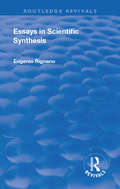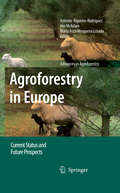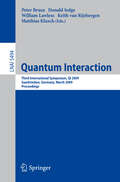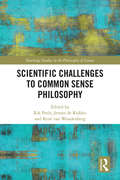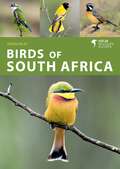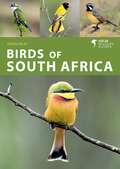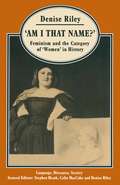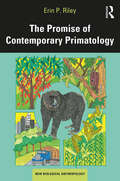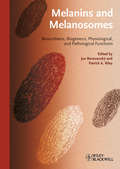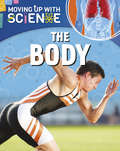- Table View
- List View
Revival: Essays in Scientific Synthesis (Routledge Revivals)
by Eugenio RignanoAlthough each of the essays in this volume is a study complete in itself, they are connected by one and the same synthetic spirit, and are animated by one and the same object: that of demonstrating the utility in the biological, psychological, and sociological fields of the theorist, who, without having specialized in any particular branch or subdivision of science, may nevertheless bring into those spheres that synthetic and unifying vision which is brought by the theorist mathematician, with so much success, into the physico-chemical field of science.
Systems Biology (Series in Systems Biology)
by Isidore Rigoutsos Gregory StephanopoulosThe advent of genome sequencing and associated technologies has transformed biologists' ability to measure important classes of molecules and their interactions. This expanded cellular view has opened the field to thousands of interactions that previously were outside the researchers' reach. The processing and interpretation of these new vast quantities of interconnected data call for sophisticated mathematical models and computational methods. Systems biology meets this need by combining genomic knowledge with theoretical, experimental and computational approaches from a number of traditional scientific disciplines to create a mechanistic explanation of cellular systems and processes. Systems Biology I: Genomics and Systems Biology II: Networks, Models, and Applications offer a much-needed study of genomic principles and their associated networks and models. Written for a wide audience, each volume presents a timely compendium of essential information that is necessary for a comprehensive study of the subject. The chapters in the two volumes reflect the hierarchical nature of systems biology. Chapter authors-world-recognized experts in their fields-provide authoritative discussions on a wide range of topics along this hierarchy. Volume I explores issues pertaining to genomics that range from prebiotic chemistry to noncoding RNAs. Volume II covers an equally wide spectrum, from mass spectrometry to embryonic stem cells. The two volumes are meant to provide a reliable reference for students and researchers alike.
Systems Biology (Series in Systems Biology)
by Isidore Rigoutsos Gregory StephanopoulosThe advent of genome sequencing and associated technologies has transformed biologists' ability to measure important classes of molecules and their interactions. This expanded cellular view has opened the field to thousands of interactions that previously were outside the researchers' reach. The processing and interpretation of these new vast quantities of interconnected data call for sophisticated mathematical models and computational methods. Systems biology meets this need by combining genomic knowledge with theoretical, experimental and computational approaches from a number of traditional scientific disciplines to create a mechanistic explanation of cellular systems and processes. Systems Biology I: Genomics and Systems Biology II: Networks, Models, and Applications offer a much-needed study of genomic principles and their associated networks and models. Written for a wide audience, each volume presents a timely compendium of essential information that is necessary for a comprehensive study of the subject. The chapters in the two volumes reflect the hierarchical nature of systems biology. Chapter authors-world-recognized experts in their fields-provide authoritative discussions on a wide range of topics along this hierarchy. Volume I explores issues pertaining to genomics that range from prebiotic chemistry to noncoding RNAs. Volume II covers an equally wide spectrum, from mass spectrometry to embryonic stem cells. The two volumes are meant to provide a reliable reference for students and researchers alike.
Agroforestry in Europe: Current Status and Future Prospects (Advances in Agroforestry #6)
by Antonio Rigueiro-Rodríguez Jim McAdam María Rosa Mosquera-LosadaAgroforestry has come of age during the past three decades. The age-old practice of growing trees and crops and sometimes animals in interacting combinations – that has been ignored in the single-commodity-oriented agricultural and forestry development paradigms – has been brought into the realm of modern land-use. Today agroforestry is well on its way to becoming a specialized science at a level similar to those of crop science and forestry science. To most land-use experts, however, agroforestry has a tropical connotation. They consider agroforestry as something that can and can only be identified with the tropics. That is a wrong perception. While it is true that the tropics, compared to the temperate regions, have a wider array of agroforestry systems and hold greater promise for potential agroforestry interventions, it is also true that agroforestry has several opportunities in the temperate regions too. Indeed, the role of agroforestry is now recognized in Europe as exemplified by this book, North America, and elsewhere in the temperate zone. Current interest in ecosystem management in industrialized countries strongly suggests that there is a need to embrace and apply agroforestry principles to help mitigate the environmental problems caused or exacerbated by commercial agricultural and forestry production enterprises.
Biomedical Application of Nanoparticles (Oxidative Stress and Disease)
by Bertrand Henri RihnBiomedical Application of Nanoparticles explores nanoparticles, their chemical and physicals properties, and how they interact in biological systems with proteins, immune system and targeted cells. Risk assessment of nanoparticles for human is described, including: cellular paradigms, transcriptomics and toxicogenomics. Finally, the applications of nanoparticles in medicine and antioxidant regenerative therapeutics are presented in several chapters with emphasis on how nanoparticles enhance transport of drugs across biological membrane barriers and therefore may enhance drug bioavailability.
Biomedical Application of Nanoparticles (Oxidative Stress and Disease)
by Bertrand Henri RihnBiomedical Application of Nanoparticles explores nanoparticles, their chemical and physicals properties, and how they interact in biological systems with proteins, immune system and targeted cells. Risk assessment of nanoparticles for human is described, including: cellular paradigms, transcriptomics and toxicogenomics. Finally, the applications of nanoparticles in medicine and antioxidant regenerative therapeutics are presented in several chapters with emphasis on how nanoparticles enhance transport of drugs across biological membrane barriers and therefore may enhance drug bioavailability.
Gas-Phase IR Spectroscopy and Structure of Biological Molecules (Topics in Current Chemistry #364)
by Anouk M. Rijs Jos OomensThe series Topics in Current Chemistry presents critical reviews of the present and future trends in modern chemical research. The scope of coverage is all areas of chemical science including the interfaces with related disciplines such as biology, medicine and materials science. The goal of each thematic volume is to give the non-specialist reader, whether in academia or industry, a comprehensive insight into an area where new research is emerging which is of interest to a larger scientific audience. Each review within the volume critically surveys one aspect of that topic and places it within the context of the volume as a whole. The most significant developments of the last 5 to 10 years are presented using selected examples to illustrate the principles discussed. The coverage is not intended to be an exhaustive summary of the field or include large quantities of data, but should rather be conceptual, concentrating on the methodological thinking that will allow the non-specialist reader to understand the information presented. Contributions also offer an outlook on potential future developments in the field. Review articles for the individual volumes are invited by the volume editors. Readership: research chemists at universities or in industry, graduate students.
Quantum Interaction: Third International Symposium, QI 2009, Saarbrücken, Germany, March 25-27, 2009, Proceedings (Lecture Notes in Computer Science #5494)
by C. J. Van Rijsbergen Matthias Klusch Peter Bruza Donald Sofge William LawlessThis book constitutes the refereed proceedings of the Third International Symposium on Quantum Interaction, QI 2009, held in Saarbrücken, Germany, in March 2009. The 21 revised full papers presented together with the 3 position papers were carefully reviewed and selected from numerous submissions. The papers show the cross-disciplinary nature of quantum interaction covering topics such as computation, cognition, decision theory, information retrieval, information systems, social interaction, computational linguistics and finance.
Scientific Challenges to Common Sense Philosophy (Routledge Studies in the Philosophy of Science)
by Rik Peels; Jeroen de Ridder; René van WoudenbergCommon sense philosophy holds that widely and deeply held beliefs are justified in the absence of defeaters. While this tradition has always had its philosophical detractors who have defended various forms of skepticism or have sought to develop rival epistemological views, recent advances in several scientific disciplines claim to have debunked the reliability of the faculties that produce our common sense beliefs. At the same time, however, it seems reasonable that we cannot do without common sense beliefs entirely. Arguably, science and the scientific method are built on, and continue to depend on, common sense.This collection of essays debates the tenability of common sense in the face of recent challenges from the empirical sciences. It explores to what extent scientific considerations—rather than philosophical considerations—put pressure on common sense philosophy. The book is structured in a way that promotes dialogue between philosophers and scientists. Noah Lemos, one of the most influential contemporary advocates of the common sense tradition, begins with an overview of the nature and scope of common sense beliefs, and examines philosophical objections to common sense and its relationship to scientific beliefs. Then, the volume features essays by scientists and philosophers of science who discuss various proposed conflicts between commonsensical and scientific beliefs: the reality of space and time, about the nature of human beings, about free will and identity, about rationality, about morality, and about religious belief. Notable philosophers who embrace the common sense tradition respond to these essays to explore the connection between common sense philosophy and contemporary debates in evolutionary biology, neuroscience, physics, and psychology.
The Digital Innovation Race: Conceptualizing the Emerging New World Order
by Cecilia Rikap Bengt-Åke LundvallThis book develops new theoretical perspectives on the economics and politics of innovation and knowledge in order to capture new trends in modern capitalism. It shows how giant corporations establish themselves as intellectual monopolies and how each of them builds and controls its own corporate innovation system. It presents an analysis of a new form of production where Google, Amazon, Facebook, Apple and Microsoft, and their counterparts in China, extract value and appropriate intellectual rents through privileged access to AI algorithms trained by data from organizations and individuals all around the world. These companies’ specific form of production and rent-seeking takes place at the global level and challenges national governments trying to regulate intellectual monopolies and attempting to build stronger national innovation systems. It is within this context that the authors provide new insights on the complex interplay between corporate and national innovation systems by looking at the US-China conflict, understood as a struggle for global technological supremacy. The book ends with alternative scenarios of global governance and advances policy recommendations as well as calls for social activism. This book will be of interest to students, academics and practitioners (both from national states and international organizations) and professionals working on innovation, digital capitalism and related topics.
Implementing Environmental Management Accounting: Status and Challenges (Eco-Efficiency in Industry and Science #18)
by Pall M. Rikhardsson Martin Bennett Jan Jaap Bouma Stefan SchalteggerThis book brings together examples of leading thinking and international practice in the rapidly developing area of environmental management accounting .(EMA) The authors include academics and practitioners from industry and the subjects covered range from individual company experiences with implementing EMA to national experiences regarding the adoption and diffusion of EMA practices.
Photobiology: The Science and Its Applications
by E. RiklisIt is not always the case that the subject of a scientific book and its relevance to everyday li fe are so timely. Photobiology and its si ster subject Radiobiology are now a must for understanding the environment we live in and the impact light, ultraviolet light, and radiation have on all aspects of our life. Photobiology is a true interdisciplinary field. Photobiology research plays a direct role in diverse fields, and a glance at the topics of the symposia covered in this book by over 100 articles shows the breadth and depth of knowledge acquired in fundamental research and its impact on the major issues and applied problems the world is facing. Half a century of photobiology research brought about an understanding of the importance of light to life, both as a necessary source of energy and growth as weIl as its possible dangers. Research in photochemistry and photobiology led to the discoveries of ceIlular repair mechanisms of UV induced damages to DNA and this led to understanding of the effects of hazardous environmental chemieals and mutagenecity , and to the development of genetic engineering. This topic was given due emphasis in several symposia and chapters in this book.
Birds of South Africa (Helm Wildlife Guides)
by Adam RileyThe definitive photographic guide to the amazing avifauna of South Africa.South Africa – from the vast savanna of Kruger to the unparalleled richness of the Cape – is one of the most biodiverse countries in the world, featuring the highest number of endemics of any African country, as well as rich seabird assemblage and vast numbers of more widespread yet no less spectacular African birds.The perfect companion for any wildlife-friendly visitor, Birds of South Africa provides photographic coverage of more than 340 species that regularly occur in the region. Concise text for each species includes information on identification, songs and calls, behaviour, distribution and habitat, with each photo having been carefully selected to guide identification. A guide to the best birdwatching sites in South Africa is also included. Portable yet authoritative, this is the perfect guide for travellers and birdwatchers visiting this spectacular and bird-rich destination.
Birds of South Africa (Helm Wildlife Guides)
by Adam RileyThe definitive photographic guide to the amazing avifauna of South Africa.South Africa – from the vast savanna of Kruger to the unparalleled richness of the Cape – is one of the most biodiverse countries in the world, featuring the highest number of endemics of any African country, as well as rich seabird assemblage and vast numbers of more widespread yet no less spectacular African birds.The perfect companion for any wildlife-friendly visitor, Birds of South Africa provides photographic coverage of more than 340 species that regularly occur in the region. Concise text for each species includes information on identification, songs and calls, behaviour, distribution and habitat, with each photo having been carefully selected to guide identification. A guide to the best birdwatching sites in South Africa is also included. Portable yet authoritative, this is the perfect guide for travellers and birdwatchers visiting this spectacular and bird-rich destination.
Restoring Neighborhood Streams: Planning, Design, and Construction (The\science And Practice Of Ecological Restoration Ser.)
by Ann L. RileyThis book presents the author’s thirty years of practical experience managing long-term stream and river restoration projects in heavily degraded urban environments. Riley provides a level of detail only a hands-on design practitioner would know, including insights on project design, institutional and social context of successful projects, and how to avoid costly and time-consuming mistakes. Early chapters clarify terminology and review strategies and techniques from historical schools of restoration thinking. But the heart of the book comprises the chapters containing nine case studies of long-term stream restoration projects in northern California. Although the stories are local, the principles, methods, and tools are universal, and can be applied in almost any city in the world.
‘Am I That Name?’: Feminism and the Category of ‘Women’ in History (Language, Discourse, Society)
by Denise RileyWriting about changes in the notion of womanhood, Denise Riley examines, in the manner of Foucault, shifting historical constructions of the category of "women" in relation to other categories central to concepts of personhood: the soul, the mind, the body, nature, the social. Feminist movements, Riley argues, have had no choice but to play out this indeterminacy of women. This is made plain in their oscillations, since the 1790s, between concepts of equality and of difference. To fully recognize the ambiguity of the category of "women" is, she contends, a necessary condition for an effective feminist political philosophy.
The Promise of Contemporary Primatology (New Biological Anthropology)
by Erin P. RileyThis book argues for a contemporary primatology that recognizes humans as integral components in the ecologies of primates. This contemporary primatology uses a broadened theoretical lens and methodological toolkit to study primate behavior and ecology in increasingly anthropogenic contexts and seeks points of intersection and spaces for collaborative exchange across the natural sciences, social sciences, and humanities. The book begins by exploring the American tradition of anthropology, providing historical and disciplinary context for the emergence of field primatology and how it became a part of this tradition. It then examines how primatology transformed into a field dominated by evolutionary approaches and highlights how the increasingly anthropogenic environments in which primates live present opportunities to understand primate adaptability at work. In doing so, it explores how an extended evolutionary approach can help explain behavioral variation in these contemporary environments. Focus is then given to the ethnoprimatological approach, a contemporary approach that provides a pluralistic framework, drawing from the natural and social sciences and humanities, needed to study human-primate coexistence in the Anthropocene. Finally, the book considers how such a crossing of disciplines can inform primate conservation in the future. An important interdisciplinary reassessment, this book will be of significant interest to primatologists, biological anthropologists, and scholars of anthropology more generally, as well as evolutionary and conservation biologists.
The Promise of Contemporary Primatology (New Biological Anthropology)
by Erin P. RileyThis book argues for a contemporary primatology that recognizes humans as integral components in the ecologies of primates. This contemporary primatology uses a broadened theoretical lens and methodological toolkit to study primate behavior and ecology in increasingly anthropogenic contexts and seeks points of intersection and spaces for collaborative exchange across the natural sciences, social sciences, and humanities. The book begins by exploring the American tradition of anthropology, providing historical and disciplinary context for the emergence of field primatology and how it became a part of this tradition. It then examines how primatology transformed into a field dominated by evolutionary approaches and highlights how the increasingly anthropogenic environments in which primates live present opportunities to understand primate adaptability at work. In doing so, it explores how an extended evolutionary approach can help explain behavioral variation in these contemporary environments. Focus is then given to the ethnoprimatological approach, a contemporary approach that provides a pluralistic framework, drawing from the natural and social sciences and humanities, needed to study human-primate coexistence in the Anthropocene. Finally, the book considers how such a crossing of disciplines can inform primate conservation in the future. An important interdisciplinary reassessment, this book will be of significant interest to primatologists, biological anthropologists, and scholars of anthropology more generally, as well as evolutionary and conservation biologists.
Transforming Urban Food Systems in Secondary Cities in Africa
by Liam Riley Jonathan CrushCountries across Africa are rapidly transitioning from rural to urban societies. The UN projects that 60% of people living in Africa will be in urban areas by 2050, with the urban population on the continent tripling over the next 50 years. The challenge of building inclusive and sustainable cities in the context of rapid urbanization is arguably the critical development issue of the 21st Century and creating food secure cities is key to promoting health, prosperity, equity, and ecological sustainability. The expansion of Africa’s urban population is taking place largely in secondary cities: these are broadly defined as cities with fewer than half a million people that are not national political or economic centres. The implications of secondary urbanization have recently been described by the Cities Alliance as “a real knowledge gap”, requiring much additional research not least because it poses new intellectual challenges for academic researchers and governance challenges for policy-makers. International researchers coming from multiple points of view including food studies, urban studies, and sustainability studies, are starting to heed the call for further research into the implications for food security of rapidly growing secondary cities in Africa. This book will combine this research and feature comparable case studies, intersecting trends, and shed light on broad concepts including governance, sustainability, health, economic development, and inclusivity. This is an open access book.
Bacteriocins: Ecology and Evolution
by Margaret A. Riley Milind A. ChavanMicrobes produce an extraordinary array of defense systems. This book tells the fascinating story about the evolutionary histories of bacteriocins and the ecological roles of these biological weapons in microbial communities. The book makes compelling reading for a multi-faceted scientific audience, including those working in the fields of biodiversity and biotechnology, notably in the human and animal health domain.
Melanins and Melanosomes: Biosynthesis, Structure, Physiological and Pathological Functions
by Patrick A. Riley Jan BorovanskyThe surface pigmentation of vertebrates is controlled by specialized cells able to synthesize a variety of pigments collectively known as melanins. Recent research has shown that melanins are produced not only in the skin but also in many other sites such as the eye, inner ear, muscles, etc., - where they are engaged in some unanticipated roles. The details of the synthetic pathway, the complexities of its regulation and biological significance that have been unravelled in recent research comprise a fascinating story and are of key importance in understanding the nature of diseases, including malignant melanoma one of the most rapidly spreading cancers.
The Body: Human Body (Moving up with Science #9)
by Peter RileyFind out all about the science in the world around us with Moving Up with Science. Written to support the National Curriculum at Key Stage 2, each title explores key scientific topics through a combination of concise information and fun experiments. Discover what happens inside your body; the way muscles and bones work together and what happens to your food as it is digested. Explore the ways you can keep your body healthy and find out about animal bodies and food chains.
Cambridge Checkpoint Lower Secondary Science Stage 7 Student's Book 1 South Asia (PDF)
by Peter RileyCambridge Checkpoint Lower Secondary Science Student's Book 7: Third Edition
by Peter RileyStage 7 is endorsed by Cambridge Assessment International Education.Help learners engage with and fully understand topics they are studying with captivating content following the new Cambridge Lower Secondary Science curriculum framework (0893). - Provide activities to increase learners' subject knowledge and develop the skills necessary to think and work scientifically.- Test learners' comprehension of each topic with questions designed to develop deeper thinking skills.- Embed knowledge and increase learners' vocabulary with whole class and smaller group discussion.
Cambridge Checkpoint Lower Secondary Science Student’s Book 8: Third Edition
by Peter RileyWe are working with Cambridge Assessment International Education to gain endorsement for this forthcoming title.Help learners engage with and fully understand topics they are studying with captivating content following the new Cambridge Lower Secondary Science curriculum framework (0893). - Provide activities to increase learners' subject knowledge and develop the skills necessary to think and work scientifically.- Test learners' comprehension of each topic with questions designed to develop deeper thinking skills.- Embed knowledge and increase learners' vocabulary with whole class and smaller group discussion.
